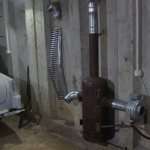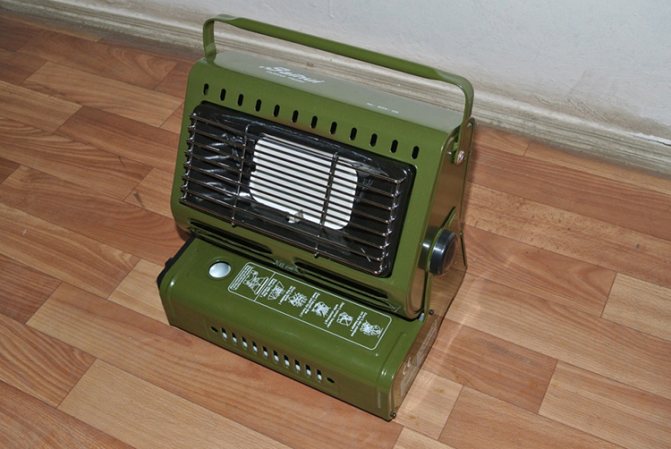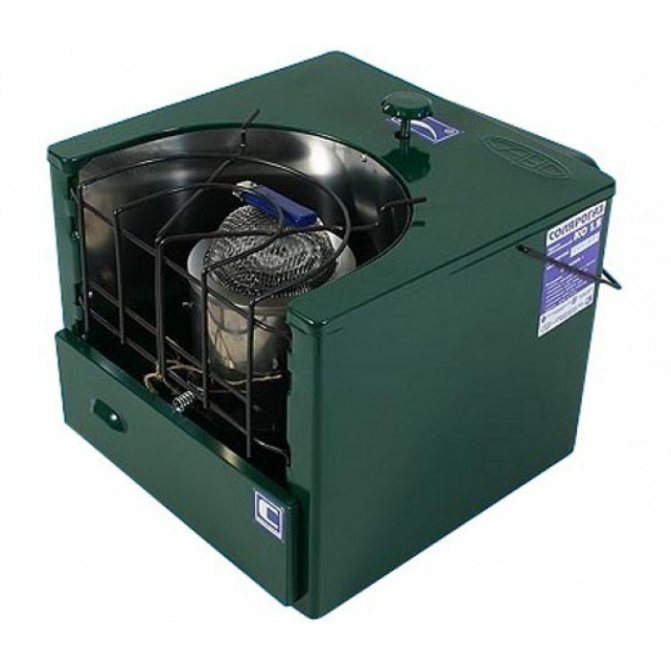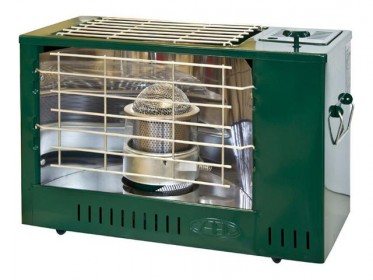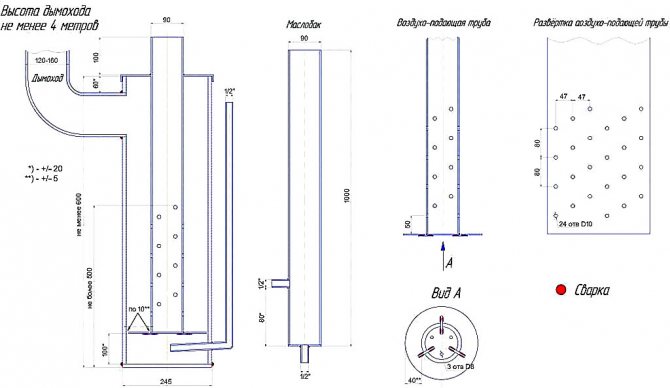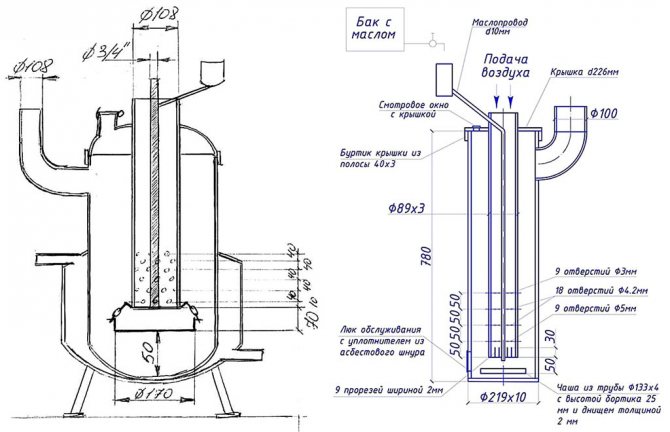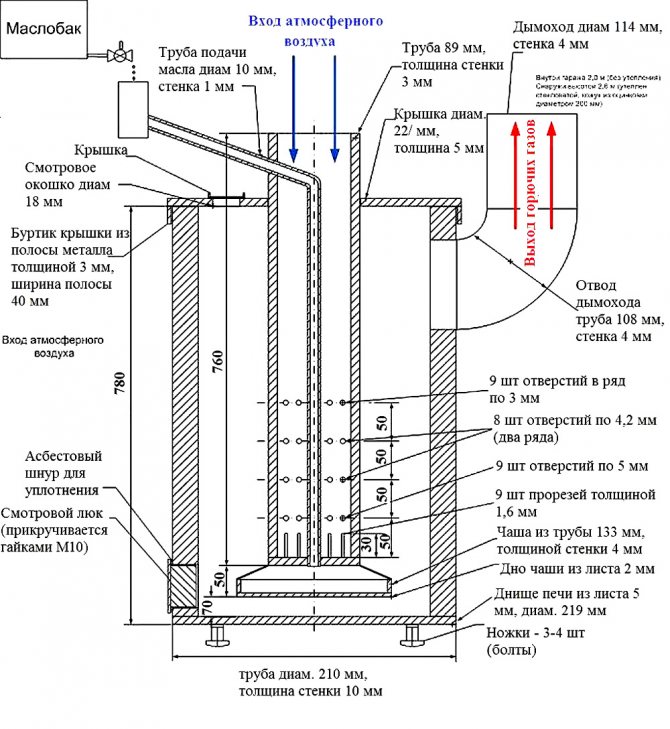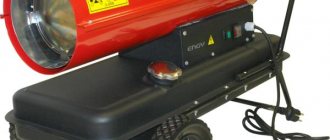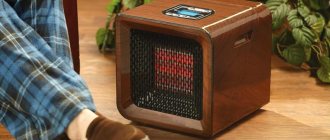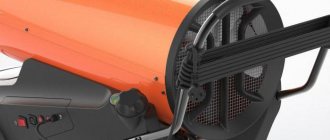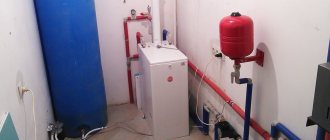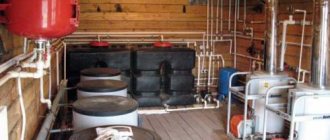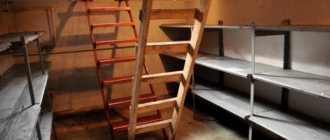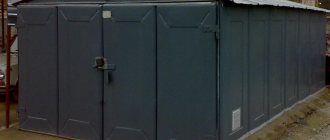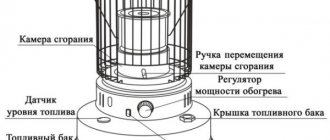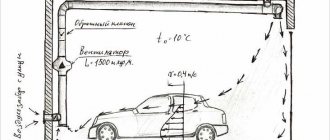The need for heating in the garage rarely causes controversy: motorists are well aware of how important it is to take care of the condition of the car, and they themselves do not want to freeze during inspections and repairs of equipment.
The main issue that needs to be resolved is the appropriate type of heating. A good option is a miracle oven with diesel fuel. Let's figure out what advantages this heating device has and how to assemble it with our own hands.
Principle of operation
The stove body contains a fuel container with a valve, a replaceable block with a filter, combustion chambers, an adjustment screw, a reflector and a wick. Liquid fuel flows from the fuel tank to the burner by gravity, its amount can be adjusted with a screw.
Collapse Contents:
- Advantages and disadvantages
- Device types
- Criterias of choice
- Power
- Material
- Winter summer
- Price
- Control systems
- Popular models
- Solyrogaz
- Aeroheat HA S2600 BOXER
- Master B35
- AOZh
- How to do it yourself?
- Materials and tools
- Blueprints
- Manufacturing instruction
- Output
Diesel fuel is heated in the wick bowl, after which it turns into a vaporous state. Further, diesel fuel vapors enter the combustion chamber, where they burn with the formation of a large amount of heat.
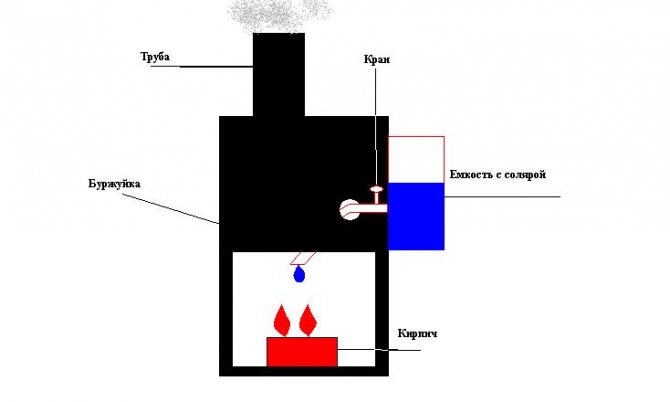
Why are diesel heaters better than others?
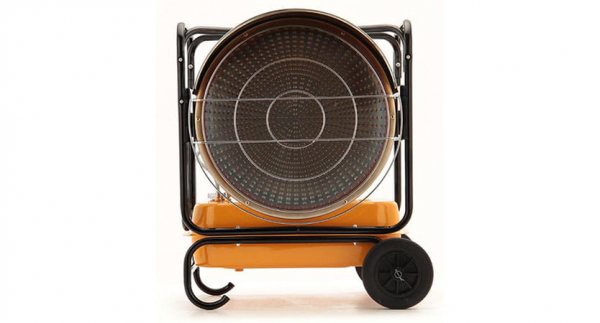

Among the main advantages are the following:
Advantages and disadvantages
Diesel fuel stoves have a number of advantages over solid fuel boilers:
- compactness, mobility. Typically, such a device is small in size and occupies a small area. In addition, the diesel fuel stove can be moved to any convenient place;
- high efficiency with low consumption of diesel fuel;
- lack of a chimney. The construction of a chimney in any room presupposes a violation of the integrity of the attic floor and roof covering, which entails additional financial expenditures both for the installation of the pipe itself and the installation of heat-resistant materials in the places where the pipe passes through the building envelope;
- combustion products during the operation of the stove on diesel fuel do not enter the room, which means that you can stay in it without fear for your health;
- the ability to adjust the temperature mode depending on the room temperature;
- no blowing is required to reach the full power of the stove.
The disadvantages of heating with a stove on diesel fuel include:
- the release of smoke and unpleasant odors at the time of ignition, therefore, for this procedure, it is better to take the unit out into the street;
- diesel fuel has a specific smell, which is felt most strongly when refueling the device.
Pros and cons of gas heaters for the garage
The benefits of using them are undoubtedly greater.
- Profitability. During operation, the devices consume a little fuel, and its affordability makes them a budget heating option.
- Compactness. Most models take up minimal space in the room. It is also possible to choose a mobile unit, which is convenient to move to areas in need of heat.
- Fuel availability.Almost any gas air heater for heating a garage has the ability to operate from a centralized line or a portable cylinder. In the first case, it is required to obtain permits from the relevant utility service.
- Efficiency. The efficiency of the equipment is quite high, since the energy released as a result of combustion is consumed by 80-90%.
- Electrodependence. If the model is not equipped with automatic equipment, it works autonomously from the network, therefore it is not subject to voltage drops, it will continue to heat the room if it is turned off.
- Affordable cost. The price of gas-fired heaters is lower than many electric, liquid-fuel appliances, heating boilers, oil radiators.
The main disadvantage of the equipment is the increased explosion and fire hazard. At the same time, it is important to understand that emergency situations occur due to illiterate operation, non-compliance with the rules and regulations prescribed by the manufacturer. In order for the gas heater for garage maintenance to work properly and without interruption, a chimney must be installed to release the combustion products, as well as to ensure a sufficient supply of fresh air from the outside.
Device types
A diesel heater for a garage can have the following types of devices:
- double-circuit gas-air or heat gun. It instantly heats up the room, but uses a lot of fuel. It is difficult to manufacture, as it requires the use of turned, milled and stamped parts made of heat-resistant materials;
- wick stove. Its device is similar to kerogas, only with an increased consumption of combustible matter. When manufacturing it, it is important to observe the geometric parameters of all parts and assemblies, since in devices working with a wet wick, the amount of heat released with an increase in the size of the device grows much faster than it is released. An unfinished oven may explode from overheating. This disadvantage limits the increase in thermal power;
- a drip unit is an efficient, economical in fuel consumption, simple in technical design, a heating device that can be easily built with your own hands from auxiliary materials.

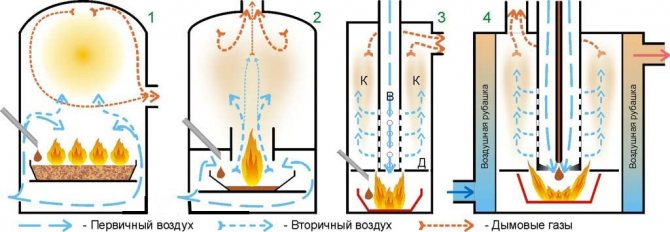
Place of application of diesel heater
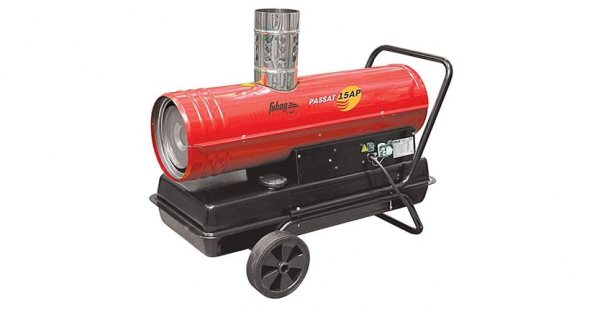

Liquid diesel heaters can be used in different rooms. The place of application depends both on the dimensions of the device and on the size of the heated room. For example, small units like heat guns are perfect for a garage.
Infrared diesel heaters will perfectly fit wherever it is necessary to heat the air in an open space: a cafe, a veranda. Note that this type of device is also suitable for a closed room.
Heaters of the solyrogaz type can be taken with you, for example, on a hike, and cook food on it, and it is also perfect for heating a summer cottage. We will talk about all these types of devices a little later.
Criterias of choice
The main criteria for choosing a prefabricated diesel fuel stove are:
- heat power range;
- material of manufacture;
- configuration and dimensions of the product.
Power
To select a stove in terms of power, one proceeds from the following ratio: per 10 m² of heated area - 1 kW of power. Accordingly, for a garage of 20 square meters, a device with a power of 2.0 - 2.5 kW will be required, for a larger area, for example, 40 - 50 square meters - a model with a power of 5 kW.
Material
The body of the device must be made of corrosion-resistant and heat-resistant material. The best according to this criterion will be stoves made of stainless steel or cast iron.
Winter summer
The main part in factory models of diesel fuel stoves is a burner or a bulb. After all, it is with its help that heat is generated. It can be made from:
- metal;
- glass.
The metal burner is less efficient than the glass burner, but is more durable and can be used for cooking in summer. If the device will be used only as a heating device, then it is better to choose a model with a glass burner. But it is better not to cook on it, since accidental ingress of water can lead to cracks on its surface.
Price
The price of the device depends on the power of the device, the number of burners, dimensions and manufacturer. A domestic-made stove can be bought for 1,800 - 5,000 rubles, imported appliances of the same capacity are more expensive in the range from 30,000 to 50,000 rubles.
Control systems
The device must be equipped with special automation that will turn it off when the flame control system overheats, regulate the temperature regime, and dose the supply of diesel fuel to the burner. Therefore, it will be possible to leave such a stove for a long time without constant control from the owner.
Content:
- Gas heaters
- Gas ceramic heaters
- Diesel heaters
- Infrared heaters
- Outcome
- Video on how to choose a garage heater
When choosing a heating option for the garage, the car owner proceeds from two main criteria:
- How much money will you need to spend on heating;
- How long is the garage heated?
These two criteria are the basis for choosing the most efficient and economical heater.
Thermal diesel cannon
- Gas;
- Gas ceramic;
- Diesel;
- Infrared;
- Solid fuel;
- Central heating;
- Homemade constructions.
Popular models
Solyrogaz
Affordable, compact, economical, not polluting the air with soot and harmful substances - these are the devices that are the standalone heaters "Solyrogaz".
They have a simple design, are not whimsical to the quality of fuel, are made of stainless steel, therefore they have heat resistance, corrosion resistance and do not rust. The characteristics of several models are shown in the table.
| Characteristic | "Mini" PO-1.8
| "Fireplace" PO-2.5
| "Lux" C-4.0 | "Duet" PO-5.0 |
| power, kWt | 1,8 | 2,5 | 2,5 — 4,8 | 2,5 — 5 |
| Fuel tank capacity, l | 1,3 — 2,5 | 2,5 | 2,5 | 2x2.5 |
| Fuel consumption, l / h | 0,2 | 0,2 | 0,25 — 0,4 | 0,2 — 0,4 |
| Burning time of one filling, h | 14 — 18 | 14 — 16 | 6 — 11 | 14 — 28 |
| Dimensions, cm | 26.5x32x28 | 56x26.5x37 | 49x29x47 | 64.5x52.5x29.5 |
| Weight, kg | 4,2 | 6,7 | 6,2 | 11 |
| price, rub. | 3000 | 3900 | 2500 | 4100 |
Aeroheat HA S2600 BOXER
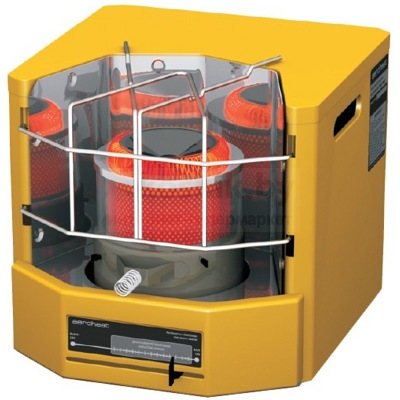

Heaters Aeroheat HA S2600 BOXER use conventional diesel fuel or kerosene for operation. They have high heat dissipation, they are able to heat a room up to 30 square meters. meters.
Characteristics:
- power -2.6 kW;
- fuel consumption - 0.2 l / h;
- fuel tank capacity - 2.5 liters;
- weight - 4.5 kg;
- dimensions - 35 x 29 x 27 cm;
- burning time for 1 filling - 10-14 hours;
Master B35
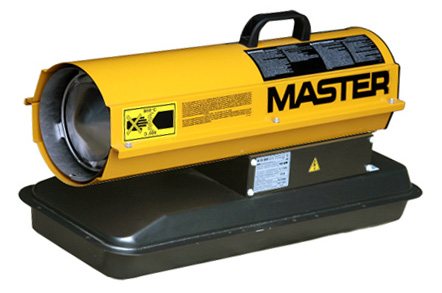

Heat guns Master B35 CED (Italy) are of high quality. They are easy to operate, do not create noise during operation, provide waste-free combustion of diesel fuel, without clogging the air with combustion waste. The approximate price of products is from 18 to 20 thousand rubles.
Characteristics:
- Efficiency - almost 100%;
- power - 10 kW;
- fuel consumption - 0.6 l / h;
- tank capacity - 15 liters;
- air flow - up to 280 m³ / h.
AOZh
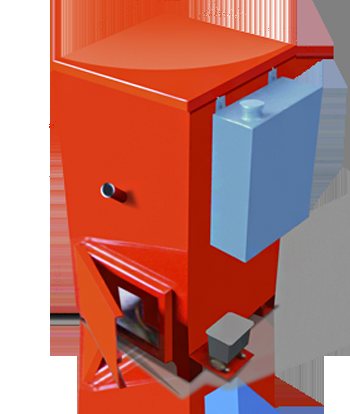

More powerful heating devices AOZh - 8.7 brands TRITON - are used to heat a room with an area of 60 - 70 m.
Specifications:
- power -8.7 kW;
- fuel consumption - 0.18 - 0.8 l / h;
- fuel tank capacity - 2.5 liters;
- weight - 45 kg;
- dimensions - 500 x 450 x 780 mm;
- burning time for 1 fuel filling - 10-14 hours.
The current rating of gas efficient garage heaters
| Model | Distinctive features | price, rub. |
| Bartolini Pullover K | Highest service life in its class. | 11 350 |
| Timberk TGN 4200 SM1 | Adapted to work in the climatic conditions of Russia. | 5 400 |
| Alpine Air NGS-20F | Excellent equipment. | 22 300 |
| Solyrogaz GII-2.9 | Affordable price. | 1 050 |
| CaliberTPG-10 | High power and efficiency. | 5 200 |
Bartolini Pullover K
An Italian-made stove equipped with a platinum-coated catalytic panel. It significantly extends the life of the active substance. Additional advantages of the model
- high degree of automation. Possibility of power regulation in the range of 1.2-29 kW, gas control function
- mobility. Convenient wheels for moving
- built-in piezo ignition
- light weight (12 kg)
- internal space for the installation of a container with liquefied fuel with a volume of 27 liters
Timberk TGN 4200 SM1
This gas ceramic cylinder garage heater is an excellent option for temporarily maintaining a comfortable microclimate. Suitable for small rooms (30-60 m2), as it has a narrowly targeted effect. It is installed on the floor and moves on wheels. The power of the unit is regulated in three positions, and at the maximum it can work continuously for up to 50 hours. Several protection options are built into the model
- rollover shutdown
- sensor indicating insufficient oxygen content in the room
- flame control
The complete set of the stove includes a fuel supply hose and a reducer.
Alpine Air NGS-20F
It is a wall-mounted convector for heating rooms up to 70 m2 with a cast-iron heat exchanger and a closed combustion chamber. This gas heater is suitable for garages, summer cottages and other detached buildings, as it can be powered by a cylinder. His dignity
- service life up to 50 years
- equipping with a coaxial chimney that discharges combustion products through a horizontal pipe
- external air consumption
- easy installation
- convenient electric ignition
- presence of a thermostat
The disadvantage of the model is its high cost.
Solyrogaz GII-2.9
The rating continues with a gas infrared heater for heating a Russian-made garage. This is an almost flat plate with extremely compact dimensions, equipped with a German-made ceramic radiator. It is widely popular with the domestic consumer due to a number of points
- budget cost
- mobility
- regulation of the position of the panel in different planes
- the possibility of cooking on it
The power of the device is 2.9 kW, which is enough to heat a small room.
CaliberTPG-10
Gas heat gun from a Russian manufacturer. Its power is 10 kW, so its scope is large garages for several cars, car repair shops, car washes, tire changers, etc. At the same time, the body of the equipment is compact, lightweight, and mobile. The device can operate on propane or butane, while fuel combustion occurs without residue and harmful emissions.
The main advantage of the Gas Air Heater Caliber TPG-10 for a garage is a high fan speed, which allows it to “process” up to 500 m3 per hour, which ensures unsurpassed work efficiency.
How to do it yourself?
Materials and tools
First you need to prepare a set of tools and the necessary materials so that they are at hand and the process of assembling the furnace is not interrupted for a long time. It should consist of:
- 50 liter cylinder for gas transportation;
- pipes Dn = 100 mm;
- profiled pipe 7x14 cm for the manufacture of a fuel tank;
- copper alloy tubes;
- steel corner;
- sheet steel;
- welding unit;
- electric drill with a set of drills;
- roulette and level;
- hammer, pliers.
Blueprints
There are several options for the design of a diesel fuel stove for a garage, which can be made by hand. For example, consider a device based on an old gas cylinder. Pechnoy.guru will provide several examples of drawings, and the decision on implementation is up to you:
Manufacturing instruction
The algorithm of actions when assembling a diesel fuel stove with your own hands should be as follows:
- free the cylinder from the remaining gas mixture and condensate;
- rinse it and let it dry;
- cut off the top with a valve;
- weld supports from the corner to the bottom of the cylinder;
- cut out a new furnace lid from sheet steel, the size corresponding to the diameter of the cylinder and make a hole in it for air supply; the hole diameter corresponds to the perforated pipe (step 8);
- cut a hole on the side of the cylinder for the chimney;
- weld a chimney with a length of at least 4 m to the larger hole;
- take pipe 89-108 (depending on the selected drawing) and make holes in the lower part according to the drawing;
- place the pipe in a gas cylinder and insert another tube with a valve (for fuel supply) inside this pipe; connect this tube to the diesel fuel tank.
- cut out a place for an inspection opening (hatch) at the bottom of the cylinder;
- install the door on the opening;
- place the fuel tank (bowl) into the cylinder;
- pour diesel fuel on 1/3 of the fuel container;
- put a sheet of paper on top of the diesel fuel and set it on fire;
- close the structure with a lid.
With an increase in temperature inside the combustion chamber, diesel fuel vapor will ignite.
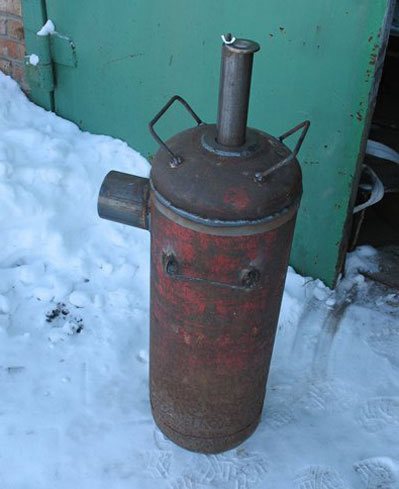

How to install a gas air heater for a garage
The main tasks of the installation are to ensure the efficiency and safety of the unit. For this, it is important to choose the right location. If it is a wall, then it must have a non-combustible finish. The distance from the body to any object must be at least 30 cm. Equipment with an atmospheric burner draws air from the room, so it is important to ensure a constant supply of air from the outside. It is not rational to create a ventilation system in a garage, so it is enough to make a hole in the ceiling.
A vertical chimney or coaxial pipe must be carefully sealed. For this, silicone or concrete mortar is used. Adding cement is undesirable as it cracks from high temperatures.
Rules for the operation of heaters of different types
So, we have considered the main types of heating systems for heating in a garage. Now with regard to the rules for the operation of such equipment.
Since the most common option is electrical heating systems, let's figure out how to use them as safely as possible:
- first of all, it is worth making sure that all electrical wiring is in good order and that the sockets can withstand the voltage of the heating device;
- in the event of an increase in humidity in the room, the risk of a short circuit increases, so this issue should be taken seriously and to prevent sudden temperature changes in the garage.
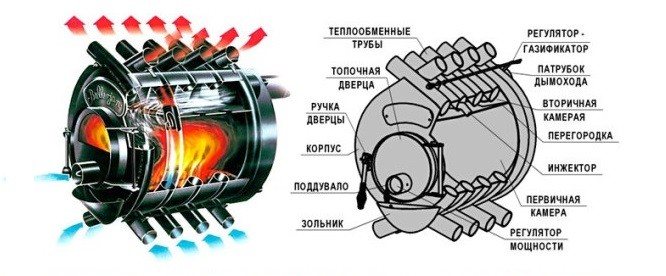

The design of the oven for heating the garage.
If we are talking about the operation of diesel or gas heaters, then you should pay attention to the following nuances:
- the likelihood of gas leakage or gasoline vaporization;
- the need to take measures of increased fire safety;
- organization of ventilation and removal of combustion products.
Well, the better to heat the garage, the owner himself decides. It all depends on the capabilities and goals pursued by the motorist.
The nuances of using infrared heaters
IR devices work on the same principle as the sun, which heats the earth. Heaters in this category heat up objects that are within their range of action, and already from them heat is emitted, heating the air in the room. Such devices can have different designs, but the main element in them is the emitter.
In everyday life, IR devices emit rays up to 600 ° C. In addition to electric models, there are examples of infrared heaters that run on gas. But the latter are not recommended for use in enclosed spaces, which are garages, due to the high level of oxygen combustion.
IR devices take up little space in the garage, and their rays can be directed to heat the vehicle.
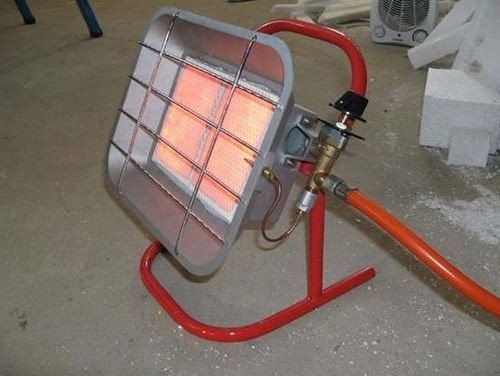

Modern IR heaters work due to the following emitters:
- Metallic. The device is based on a low-temperature stainless steel heating element in combination with aluminum heating plates. The most primitive design, which is also the most reliable.
- Ceramic.They work due to a metal spiral, which in turn heats up a ceramic panel covered with black paint. They are characterized by low efficiency.
- Micathermic. In this case, the emitters are covered with mica. They are characterized by a very low surface temperature of the emitting instrument - no more than 60 ° C. Relatively high cost compared to the options described above.
- Quartz. The heating element is a tungsten filament enclosed in a quartz glass vacuum tube. Requires careful use.
- Halogen. The tube is not vacuum, but filled with an inert gas. The filament temperature is higher than the quartz heater.
- Carbon fiber. The heating element consists of a carbon filament enclosed in a quartz glass vacuum tube. They have higher efficiency rates in comparison with the lamp-type heaters described above.
In most cases, infrared devices operating on an aluminum plate are used to heat the garage. They are cheap, but at the same time they are characterized by high indicators of reliability and durability. They are also resistant to mechanical stress, which is very important for domestic use.
The temperature indicators of such devices do not exceed 300 ° C - below the ignition temperature of paper and wood. Therefore, the heating element itself largely meets the fire safety requirements. In addition, this temperature does not provoke oxygen combustion.
And this suggests that a person can work in such a room without prejudice to his health.
When choosing an infrared heater for a garage with a radiator from a plate, you should pay attention to the thickness of the anode spraying. It is recommended that it is not less than 25 microns.
The housing of the heating element must be made of stainless steel - in this case, it will not undergo corrosion processes during changes in the level of humidity in the room.
Advantages of infrared heaters:
- uniform heating of premises with the possibility of local heating;
- there is a possibility of heating hard-to-reach places.
Among the disadvantages is only that such devices are more suitable for maintaining the required temperature level in the room than for quickly warming it up.

